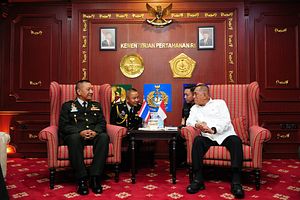Last week, Thailand’s military chief paid a trip to Indonesia. While the interaction was just one of several between the two Southeast Asian states, it nonetheless put the focus on the efforts by both sides to strengthen and further institutionalize their defense relationship despite lingering challenges at home and abroad.
Indonesia and Thailand, Southeast Asia’s largest economies and among the initial founding members of the Association of Southeast Asian Nations (ASEAN), have long had a bilateral relationship dating back to 1950. But their defense ties have been slower to develop, relatively speaking, despite the convergence of general interests on issues ranging from maritime security to counterterrorism.
Over the past few years, both sides have tried to further strengthen and institutionalize relations in this realm to extend things beyond basic aspects like visits and exchanges and addressing issues such as illegal fishing. A case in point in this respect was the inking of a memorandum of understanding on defense cooperation in 2015, which was finally ratified in 2018.
Last week, the defense aspect of the relationship was in the headlines again with the visit of the Thai military chief to Indonesia. Royal Thai Armed Forces Commander General Ponpipaat Benyasri made a scheduled visit to Indonesia in the latest high-level exchange between the two Southeast Asian states. Ponpipaat’s trip came at an interesting time for both countries, with Thailand preparing for active upcoming months of summitry later this year as the holder of the annually rotating ASEAN chairmanship for 2019, and both countries having just held elections that raised questions about the future evolution of their domestic politics and foreign policy.
Ponpipaat’s trip included several engagements. But the highlight of the trip was a meeting with Indonesian Defense Minister Ryamizard Ryacudu and a string of other Indonesian defense officials, which occurred on April 25 at the office of the Indonesian defense ministry in Jakarta.
Per the Indonesia’s defense ministry’s account of the meeting, both sides reviewed the state of security cooperation between them and discussed issues of mutual interest. They also suggested areas where defense collaboration could be strengthened, including tackling terrorism and managing natural disasters. Both also discussed ways to increase functional components of defense ties, from joint exercises related to specific issue areas to increasing visits between defense ministry and military officials between both countries.
To be sure, Ponpipaat’s trip and the discussions therein are only one interaction within the defense relationship between the two countries. But viewed from the perspective of broader trends such as the gradual formalization of defense ties between the two Southeast Asian states, such engagements nonetheless bear careful watching to get a sense of where this relationship is and where it is headed.

































